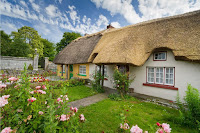“Setting is the soul of your story…improve upon it, and it will take your writing to the next level.”—Ruth Ann Ridley
I have scuttled through a twisty topiary maze with a crazed psychopath at my heels. (The Shining, by Stephen King)
On a passenger train in a remote area of Yugoslavia, I have bolted myself into my compartment and pressed my ear to the door, listening for a killer’s approach. (Murder on the Orient Express, by Agatha Christie)
In a crowded pub in Kilbane, County Cork, I’ve danced a jig and enjoyed a pint. (The Irish Village series, by Carlene O’Connor)
I have contemplated life as I gazed at the snowy branches of a trio of pines trees in Quebec. (The Three Pines series, by Louise Penny)
These fictional journeys were made possible thanks to masterful authors and their skill at creating vivid, authentic settings. I strive to learn everything I can from their talent.
As a mystery writer, I know my stories won’t flourish without a solid plot, complete with a page-turning pace and a few twists along the path. And an engaging cast of characters is the core of any good series, leaving readers excited to visit these people (and animals) again and again.
But if plot and character serve as the foundation, setting gives the story wings. Whether it adds to the feeling of camaraderie or the sense of isolation, whether it offers comfort or produces anxiety, a story’s setting helps pose themes, reveal characters’ worldviews, and define the overall tone.
When I started writing my Callie Cassidy Mystery series, I had a setting in mind before a single character was born. I knew I wanted the books located in a mountainside village. My family had visited Estes Park many times, and it became the inspiration for the fictional Rock Creek Village that Callie and her family and friends inhabit. With that template in mind, I designed my own small town and nestled it into the foothills of the Colorado Rockies.
But it turns out creating an interesting setting isn’t easy, nor is maintaining it. What are the changes we see each season? How does the place look at different times of the day? Who lives where, and whose shops neighbor each other? Above all, how do I keep describing the place in fresh ways?
Negotiating those questions is part of the artistry of writing, and I’ll never completely master it. And thank goodness for that—otherwise, I might as well give up and let the AI software do all the work.
“I always strive to create a setting that leaves the readers’ imagination room to roam. That way, every reader sees the story through their own eyes.”—P.S. Bartlett
I shared some settings I love. Now, what are some of your favorites?






Such a tricky balance between too little setting to stir the reader's imagination and too much setting to stifle the reader's imagination. And different readers prefer different spots on that spectrum!
ReplyDeleteCongrats on your newest (almost) release.
Congrats on your latest release! It's tough, balancing too many pages of what reads like a guidebook description with too little information. I'm all about the smells of a place, sources of light, and of course, trees and flowers. And birds.
ReplyDeleteYes, giving enough information to set a scene while leaving room for the reader to fill in the blanks is a skill that some authors have mastered well. I know I tend to under-describe, so I am working on providing significant details that enhance but not overwhelm the story.
ReplyDeleteWeaving setting details in an artful way into the story: the high bar we all strive to reach.
ReplyDeleteI recently read Other Birds by Sarah Addison Allen and was entranced by the primary setting: The Dellawisp, an apartment complex on fictional Mallow Island. It was a good reminder that a great setting doesn't necessarily have to encompass miles.
Congratulations on your latest! It's a tough balance and it's so wonderful when an author brings the reader into the scene.
ReplyDeleteGood discussion of setting, Lori. I love it when readers tell me they want to visit the towns in my books. Better yet, when they want to move there. Too bad the towns only exist in my imagination and the books.
ReplyDeleteCreating a new setting is such fun. I'm about to do that soon, when I start my new series.
ReplyDeleteI agree, Jim, and the same is true of character description. As a reader, I prefer to help create the settings and characters in my mind, with just a bit of direction.
ReplyDeleteThank you, Margaret! I love sensory descriptors and fear I don't use them enough.
ReplyDeleteYou're so right, Kathleen—it's very difficult to find the sweet spot, for me anyway.
ReplyDeleteI've not heard of Other Birds, Lynn, but will check it out. I'm always on the search for how to do this writing thing better!
ReplyDeleteThank you, Kait. It's also a challenge for me in a series because some readers already have an overview of the setting, while new readers need more!
ReplyDeleteThat's so fun, Molly! And when readers assume your fictional setting is a real place!
ReplyDeleteIt is fun, Marilyn--and also a lot of creative effort! Where is your new series going to be set?
ReplyDeleteProviding description is a real balancing act. I remember my mother saying that she skipped descriptions. So I have to work hard to add enough description to give readers a real sense of place without boring them. I think I should have been a playwright, which doesn’t use any description except stage direction.
ReplyDeleteSuch a good point about being a playwright, Grace. I think that would come with its own set of challenges, though—like no internal dialogue to help advance characterization!
ReplyDelete